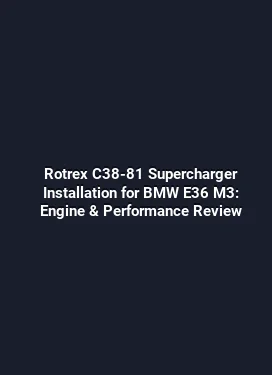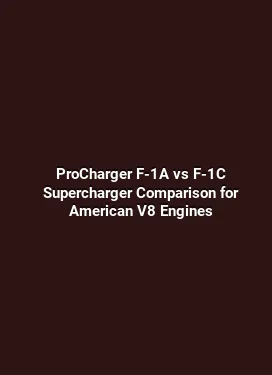How to Upgrade Turbo Wastegate Actuator on Volkswagen GTI MK7
Upgrading the turbo wastegate actuator on the Volkswagen GTI MK7 is a popular modification for enthusiasts seeking more precise boost control, faster response, and improved reliability under higher boost conditions. The MK7 chassis, featuring an efficient turbocharged 2.0-liter EA888 engine, benefits from an actuator upgrade when pushing beyond stock performance levels or when addressing aging components. This guide provides a detailed, practical approach with real-world steps, considerations, and maintenance tips to help you choose the right actuator and install it successfully while maintaining driveability and safe operation.
Understanding the wastegate actuator and its role in the MK7

The wastegate actuator is a small, vacuum- or electronically operated device that controls the opening of the wastegate, thereby regulating the amount of exhaust gas that bypasses the turbocharger. In the MK7, reliable boost control is essential for consistent power delivery, especially under intermittent load or high- RPM scenarios. As the engine ages or when higher boost targets are pursued, upgrading the actuator can reduce surge, improve bleed control, and minimize boost creep that can occur with worn or undersized components.
Key functions and benefits

When selecting and installing a new actuator, several practical benefits are often observed: tighter boost tolerance, reduced lag or spike, more predictable spool behavior, and the potential for safer operation at elevated boost levels. A well-chosen actuator also tends to exhibit longer service life under aggressive driving, provided supporting components such as the intake tract, intercooler hoses, and vacuum lines are in good condition.
Choosing the right wastegate actuator for the MK7
The MK7’s turbo system relies on a compact actuator that can be influenced by vacuum integrity, mechanical clearance, and the overall boost target. When upgrading, factors to consider include material quality, actuator travel, spring rate, and compatibility with the stock or upgraded turbocharger. Options range from high-quality stock replacements designed for higher load, to aftermarket units with adjustable spring pressures for finer boost control. It is important to evaluate installation space, sensor compatibility, and whether the actuator is a direct-fit unit or requires adapters.
Spring rate, travel, and adjustment considerations
Actuators use spring tension to determine the baseline boost and how aggressively they respond to pressure changes. A stiffer spring can raise the target boost, but may also increase sensitivity to pressure fluctuations and cause surge if the rest of the system cannot support the change. Conversely, a softer spring can offer smoother transitions but might limit the maximum boost. Some aftermarket units provide adjustable travel and spring selection, enabling calibration to the chosen exhaust, intake, and intercooler configuration. When selecting an actuator with adjustable characteristics, plan a methodical approach to calibration to preserve safe engine operation.
Preparation: assessing the current system and prerequisites
Before removing the stock actuator, perform a thorough inspection of the surrounding components. Vacuum lines should be intact and free of cracking or brittleness, the intercooler hoses should seal properly, and the turbo outlet should show no signs of exhaust leaks. Check for any wobble or play in the actuator linkage, and inspect the wastegate arm for smooth movement. A small amount of lubricating spray on moving joints can help detect binding, but avoid direct lubrication of the diaphragm itself, as residue can degrade performance.
Tools and consumables you’ll need
A typical upgrade requires standard hand tools, including screwdrivers, pliers, and wrenches, plus a suitable metric set. Depending on the actuator type, you may need thread sealant, new vacuum hose, zip ties, and a clean workspace. Safety is paramount; work with the engine off and cooled, and use wheel chocks and a stable setup to prevent movement during the procedure.
Step-by-step installation guide for the MK7 wastegate actuator
The following steps outline a thorough, practical installation process. Always refer to the specific actuator’s installation manual for torque specifications and any model-specific instructions, as designs can vary between OEM replacements and aftermarket units.
Step 1: Gain access and remove the stock actuator
Begin by disconnecting the battery to prevent any accidental electrical contact. Locate the stock wastegate actuator near the turbocharger. Detach any vacuum lines or electrical connectors from the actuator, noting their routing for accurate reassembly. If the actuator is behind heat shields or tight ducts, carefully remove protective coverings to access the mounting bolts. Keep track of mounting hardware in case you need to reuse any components.
Step 2: Inspect and document the wastegate linkage
Before removing the actuator, note the position of the wastegate arm and the linkage. Some installations require adjusting the linkage length to achieve correct alignment with the new actuator’s travel. Take pictures or mark alignment reference points to guide reassembly. Check for any binding or wear in the linkage pivot points and address these before continuing.
Step 3: Install the new actuator
Position the new actuator in the same orientation as the stock unit to ensure proper clearance with surrounding components. Secure the mounting bolts to the manufacturer’s recommended torque, avoiding overtightening that could warp the housing. Reconnect vacuum lines or electrical connectors exactly as they were configured, ensuring a snug and leak-free seal. If the new actuator includes an adjustable setting, begin with a conservative baseline to minimize the risk of introducing excessive boost immediately after installation.
Step 4: Reconnect the wastegate linkage and verify movement
Reattach the wastegate linkage, ensuring there is smooth, unimpeded movement across the actuator’s full travel. Manually actuate the linkage to confirm the diaphragm moves freely without binding. If stiction is evident, recheck the linkage alignment or apply a light lubricant to pivot points (avoid lubricants on the diaphragm). After mechanical verification, inspect all hose connections for proper seating and absence of kinks or leaks.
Step 5: Vacuum source and system integrity
For vacuum-operated actuators, ensure the vacuum source is clean and free of leaks. A vacuum test can help identify hidden leaks: apply a controlled vacuum and monitor for any drop in pressure. A leak anywhere in the system will translate into inconsistent boost behavior. For electronically controlled actuators, verify sensor input and wiring integrity, ensuring there are no loose connections or damaged harnesses.
Step 6: Initial calibration and road testing
With the system reassembled, perform a cautious initial road test in a safe environment. Monitor boost behavior using a reliable gauge or data logging interface if available. Start at a conservative boost level and gradually increase while ensuring there are no boost spikes, erratic fluctuations, or audible flutter from the intake. If the system displays any abnormal behavior, reevaluate the actuator settings, vacuum integrity, and linkage alignment.
Boost control, tuning considerations, and data-driven improvements
Upgrading the wastegate actuator is not only about hardware; it also impacts how the engine manages boost under different driving conditions. For MK7 owners aiming for higher performance, a coordinated approach involving exhaust constraints, intake flow, intercooling efficiency, and calibration strategies pays dividends in drivability and reliability. Real-world driving data helps identify trends such as turbo lag, boost stability at high RPM, and response under throttle modulation. Integrating these observations with cautious, incremental tuning adjustments yields the best results.
Interpreting sensor feedback and driveability
Reliable boost control relies on consistent sensor feedback from the engine computer, the pressure sensor, and the actuator’s position signals. If you notice delayed boost onset or unexpected surges, reevaluate the actuator’s baseline setting and the vacuum plumbing. A smoothly rising boost curve with minimal spikes typically indicates a well-matched actuator and a healthy intake path. Discrepancies may warrant a recheck of sealing surfaces, vacuum integrity, or, in some cases, a recalibration of the actuator’s travel limits.
Maintenance, reliability, and long-term considerations
Regular inspection of the wastegate system helps prevent performance degradation over time. Tireless driving conditions or exposure to high heat can accelerate wear on vacuum hoses and seals. Periodically inspect hoses for cracks, brittleness, or swelling and replace them if necessary. Clean connections, ensure dust covers or shields are intact, and verify that the actuator’s mounting remains tight. A proactive maintenance plan reduces the likelihood of boost inconsistencies and helps preserve the benefits of the upgrade.
Common issues and quick fixes
Boost inconsistencies can arise from several sources: worn vacuum lines, loose clamps, diaphragm damage, or misalignment of the linkage. If you experience a noticeable drop in boost or inconsistent response, start with a vacuum integrity check, replace damaged lines, and verify the actuator’s seating. In some scenarios, reseating the actuator or refreshing the protective covers around hot components can prevent heat-related binding and extend component life.
Real-world tips and best practices
To maximize the benefits of an upgrade while maintaining safe operation, adopt a methodical approach: document baseline boost behavior, implement the upgrade with attention to vacuum integrity, perform staged testing, and monitor engine data during each adjustment phase. A well-planned upgrade often yields more predictable performance across a wide range of driving scenarios, from daily commuting to spirited street driving. Keep in mind that some vehicles may require minor ECU adaptations or fuel trim adjustments to harmonize with the new boost dynamics, especially when higher boost targets are pursued.
Safety-minded testing and monitoring
Always conduct tests in controlled environments. Begin with short, low-risk sessions to confirm stability, then progressively explore higher boost levels as confidence grows. If any abnormal noises, leakage, or sudden power loss occur, pause the test and re-evaluate. Maintaining a safe margin between maximum boost and the engine’s knock and timing limits reduces the risk of long-term damage.
Long-term performance considerations for the MK7 platform
When the wastegate actuator upgrade is part of a broader performance plan, consider how this change interacts with other components: intercooler efficiency, intake airflow, exhaust flow, and fuel delivery. A balanced approach often yields more consistent power delivery and improved throttle response. Over time, upgrading ancillary components to support higher boost can reduce the need for frequent recalibrations, provided the system remains well-sealed and within the engine’s safe operating envelope.
Summarizing practical outcomes
Expect improved boost stability, more predictable response to throttle input, and enhanced control under higher boost scenarios. The upgrade should feel more linear and controllable rather than exhibiting abrupt spikes or lag. Regular inspections and cautious tuning adjustments are essential to preserve these benefits and maintain engine reliability under spirited driving conditions.





